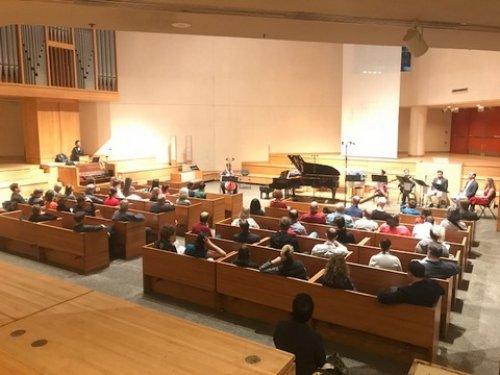If Not Now …? Chamber Music of Timothy Brown
A rewarding evening of chamber music, composed many years ago, by a NYC composer currently best known for recent choral compositions.

Composer Timothy Brown
[avatar user=”Jean Ballard Terepka” size=”96″ align=”left” ] Jean Ballard Terepka, Music Critic[/avatar]Composers, like all artists – like all regular people, in fact – go through extended phases, periods in their lives that over time morph, becoming something else, sometimes even seeming to disappear entirely. Of course, artifacts remain, perhaps taking on a life of their own. Or time reveals that the distinguishing features of a particular phase haven’t ceased to be, they’ve simply reorganized their place and shape in ongoing living.
In recent years, composer Timothy Brown has mostly been writing short choral works – the sorts of pieces featured in the concerts of C4, of which Brown has been a member for the last decade – rather than more extended instrumental works. In If Not Now …?, Brown presented six pieces composed in an earlier phase of his composing life, the decade between 1997 and 2006. Two pieces were solo instrumental works; one was a six-movement work for voice, piano and contrabass; the remaining three were chamber works for various collections of instruments. All of them were substantive and exciting, presented by musicians who clearly enjoyed their material. In the bright, clear, clean space of St. Peter’s Church, the atmosphere of the concert was informal and congenial. Brown indicated in his program notes that he hoped the event would be “like a house concert among friends.” Happily, it was.
Brown also described what he hoped would be his audience’s state of mind: he encouraged listeners to “sink into the work a bit, like you might … sitting in front of a painting at your favorite museum.” More than just a friendly invitation, Brown’s hope proves a useful guide for thinking about Brown’s music.
Brown writes expressively, easily conjuring up pictures and tableaux vivants, stories and vignettes. His compositions are intelligent and urbane, confidant and conceptually rich; sad wisdom and ruefully observant wit both flourish in Brown’s music, equal partners in the composer’s analysis of the world whose vagaries inspire and intrigue him.
The opening piece, the eleven-minute, three-movement 1997 Sonatina for Solo Cello, revealed Brown’s capacity for both cerebral elegance and sensuous meditativeness. Cellist Caroline Stinson presented Brown’s technically demanding, formal music with graceful command.
The second piece, The Boathouse in Winter (Central Park), written in 2001, was played marvelously by John Romeri/flute and piccolo, Keve Wilson/oboe and English horn, Nicholas Gallas/clarinet and bass clarinet, Gina Cufari/bassoon, and Chris Komer/horn. Brown’s witty and virtuosic writing organizes all these wind instruments into a round-robin of duets, interruptions and conversations, successfully summoning up the image of various mini-scenes of birds – and the occasional human – around the pre-spiffed-up Central Park Loeb Boat House. In the music, naturalism and abstraction existed both on their own and as vehicles for visual and experiential remembering.
Pianist Blair McMillen played the 1999 Incidental Dance Suite. Each of the three movements – Tango, Waltz and Swing – captured the essence of the particular dance. The Tango explored wild intersections of flirtatious irony and full-breathed passion; the Waltz evoked the sensuous Romanticism (and contained occasional echoes of Robert Schumann’s 1837 Davidsbundlertanze); mature, sexy Swing presented syncopations as strategies for both jazzy conversation and hot embraces.

If Not Now …? Chamber Music of Timothy Brown at St. Peter’s Church (April 24, 2018)
After a short intermission, the second half of the concert opened with a formal, though short, Sonata for Clarinet and Piano, with Gallas and McMillen. This gorgeous piece – meditative and expressive, an examination of the psyche’s capacity to move swiftly, forward and back and forward again, along various emotional paths from jocularity to melancholy, internal preoccupation to sensuous invitation – is marked by particularly beautiful writing for the clarinet, both on its own and in conversation with the piano. This Sonata should become a standard part of clarinet-piano literature.
Following the Sonata was Epitaph: Four Songs on Poems of Dorothy Parker, featuring mezzo-soprano Theodora Hanslowe, pianist McMillen and contrabassist Samuel Zagnit, a fifteen-minute heart-wrenching depiction of a woman’s downward spiral from loss-in-love to wretched death. This trio-cum-theater-piece isn’t so much a narrative as a witness to bitter and angry depression: it is a fully realized, deeply dark psychological portrait. In Hanslowe’s richly virtuosic singing, at once disciplined and deeply emotional, a woman’s anguish was laid quite bare; the unusual accompaniment – contrabass and piano – had the look of a jazz combo, but conveyed what might have been a theater or opera scene, the final appearance of a woman who offers to her listeners not a memento mori but a fatalistic admonition to live more self-protectively if you can. Though only fifteen minutes long, Epitaph contains a complete world of art and meaning.
The last piece on the program, Vesalius’ Body was written in 2006. But, as Brown noted just before introducing it to the audience, it had never, ever been played before, and Brown, like the rest of us, was hearing it for the first time. In the capable hands of the quartet – Nurit Pacht/violin, Max Mandel/viola, Caroline Stinson/cello and Isabelle O’Connell/piano – however, the music seemed like material they’d been familiar with for years.
The five movement work was originally commissioned for a dance project. The dance fell through, but the music’s examination of the constitutive elements of ‘body’ – blood, bone and flesh – remained, transformed into a sustained consideration of the constitutive elements of personal and artistic self. In beautiful writing for all four instruments, fluidity and structure, sensuous lyricism and angular urgency all coexist.
The work culminates in two ravishing affirmations. The penultimate moment of the work is complex and large: the quartet is triumphantly symphonic. Immediately thereafter, the sudden conclusion is a note-by-single-note movement from piano and then pianissimo to the creation of a gracious, generous silent space for memory and rest.
Brown called his concert, If Not Now …? implying, for himself and us, then, when? Removed by more than a decade from the kinds of composing in which he’s now typically engaged, the pieces presented in this concert were fondly remembered by some members of the audience – Brown’s friends and colleagues of long standing – and greeted with delight by other listeners who’d never heard them before. Whether or not Brown returns to composing either non-choral chamber music or more lengthy pieces such as those performed in this concert, the evening was a happy occasion to hear music that’s been unheard for many years.
If Not Now …? Chamber Music of Timothy Brown (April 24, 2018)
St. Peter’s Church, 619 Lexington Avenue at 54th Street, in Manhattan
For more information, visit http://www.timothybrownmusicnyc.com
Running time: two hours including one intermission




Leave a comment